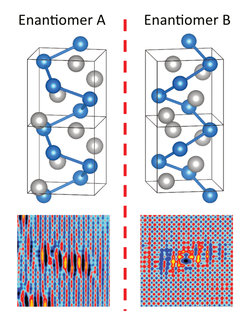Topological control by tuning structural chirality
Chiral crystals that have a distinct handedness have recently emerged as one of the most exciting new classes of topological materials. An international research team from institutions in Germany, Switzerland, United Kingdom, and China has now demonstrated that their crystal handedness directly determines how quasiparticles propagate and scatter at impurities in such materials. The study, published in the journal Nature Communications, represents a significant advance towards novel chiral electronic devices.
A chiral object cannot be superimposed onto its mirror image – a notable example, your own hands. Chirality plays a critical role in many branches of sciences, from biology to chemistry. The interaction between molecules or biological components depends on their chirality, thereby affecting drug development, for example. The optical and transport properties of solid-state systems can be strongly influenced by chirality and even the ground states of such systems may be chiral. For example, magnetic materials can spontaneously form chiral non-collinear spin-textures such as skyrmions or anti-skyrmions.
More recently, scientists predicted entirely new classes of quasiparticles in topological materials that are chiral. These predictions were confirmed by detailed inspections of their electronic structure using angle resolved photoemission experiments. These materials include the binary compounds CoSi, RhSn, and PtAl that have a chiral crystal structure (space group, 198). Clear signatures of chiral electronic behavior have now been revealed by physicists at the Max Plank Institute of Microstructure Physics, in Halle, Germany in one of these materials, the chiral semimetal PdGa. In these experiments, the powerful imaging technique of scanning tunneling microscopy was used to directly visualize how unconventional quasiparticles that are hosted on the surface of PdGa propagate and interact with the crystal environment. This goal was elegantly achieved by using one of the basic concepts of quantum mechanics: the particle-wave duality of the unusual quasi-particles in PdGa. In particular, very prominent chiral quantum interference patterns were directly imaged in the scattering of these quasi-particles from defects at the surface. It was found that these patterns display opposite handedness in two crystals of PdGa that are chiral twins. In agreement with theoretical predictions, this phenomenon was found to directly stem from the deep connection between chirality in real and reciprocal space, being a direct manifestation of the change in sign of the Chern number (an integer used to classify topological materials) upon changing the crystal’s handedness. Moroever, the researchers demonstrated the persistence of non-trivial Fermi arcs over a very large energy range of more than 1.6 eV, almost symmetrically centered around the Fermi level, revealing that PdGa is a near ideal topological conductor.
“It was very exciting to visualize how the structural bulk chirality can profoundly affect how topologically protected surface states propagate, scatter, and interfere. These observations provide the first real space experimental evidence of a distinct feature which make topological chiral semimetals distinct from all other topological semimetals known to date” said Paolo Sessi, the lead author of the study.
A challenging prerequisite for these experimental observations was the synthesis of both enantiomers of the very same compound, a goal achieved by Kaustuv Manna, a scientist at the Max Planck Institute for Chemical Physics of Solids Dresden.
“The study is an example of an excellent collaboration between research groups embracing state of the art but complementary expertise,” says Stuart Parkin, director of the NISE department at the Max Planck Institute of Microstructure Physics. “Chiral structures are of great scientific interest and these results pave the way to the exploitation of chiral topological phenomena to create devices with unique functionalities”
CF/MPI CPfS













